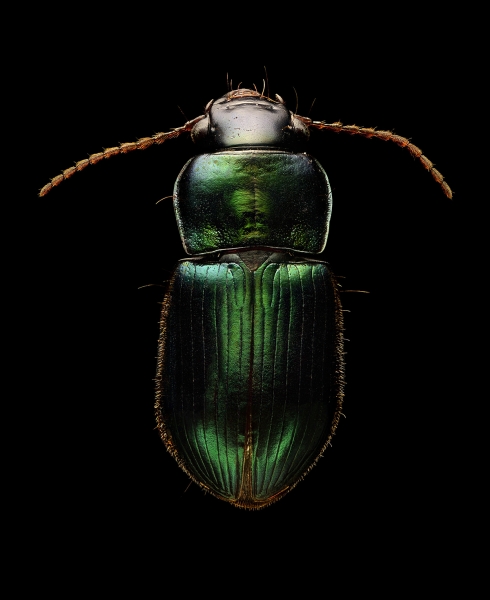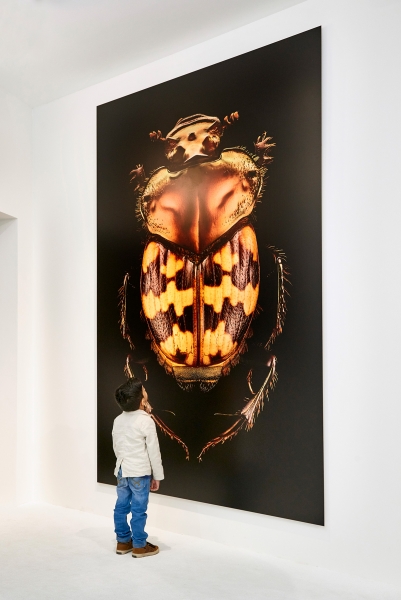It was a ground beetle. Levon Biss’ son Sebastian brought the ordinary bug in from the garden on a spring day, and Biss placed it under Sebastian’s microscope. “There was nothing special about this insect,” explained Biss in his 2017 TED Talk. “It’s a common species.” And yet, under the microscope, its glowing green back looked gorgeously speckled as if with stars. “When I first saw it, it reminded me of a galaxy,” Biss says. “And all the time, this had just been outside our window.”

© Levon Biss
Biss made an image of the insect for Sebastian. It turned out to be the first in a long series of macro insect portraits, “Microsculpture,” he’s made since that serendipitous day in 2014. In truth, at the time, Biss was looking for new direction and had already been researching macro photography, he says. Based in the United Kingdom, Biss was a successful commercial photographer, making images of sports and celebrity icons worldwide. But 18 years into that specialty, he was beginning to see his workload decline. “The way we consume images now is in a different form than when I started in advertising,” he says. “Everything we look at these days is digital. Ads go through digital billboards or the internet. You don’t need a giant 100 megapixel camera and files for that.”
Hoping to shed his reliance on commercial work, Biss craved a specialty that would put him in high demand. “You make yourself the best in this one very particular area, find something that is so niche that you don’t have any competition,” he says. After Biss made the photograph of Sebastian’s beetle, he realized the possibilities of macro photography trained on tiny subjects. “That’s how it came about. That was the thing I was looking for.”

Scaling up
When Biss began making insect portraits in earnest, he reached out to the Oxford University Museum of Natural History, asking for access to its collection of insect specimens. Impressed by his work and realizing the potential impact of large-scale prints of tiny insects otherwise tucked away in drawers, the museum permitted Biss to take its insects back to his studio for photography sessions. Over two and a half years, Biss made images of 37 specimens. Those works led to a website (microsculpture.net), a book (“Microsculpture: Portraits of Insects”), and a traveling exhibition of the enormous 3-meter-plus prints at natural history museums and public spaces around the world, including the Oxford University Museum of Natural History itself. The works have been exhibited at museums in the United Arab Emirates, Switzerland, and the United Kingdom, with upcoming shows scheduled for Denmark, Germany, and the United States.
“I have not really done any PR on the project,” says Biss. “It’s just had its own little legs.” Within the first seven days of Oxford University posting a behind-the-scenes video about the photo series on its Facebook page, the Vimeo video had accumulated 14.7 million hits. “That kickstarted it, and it’s been going around the world ever since.”

In microns
Biss frequently receives emails from photographers inquiring about his technique, searching for a particular formula for making such crystal clear, microscopic images. “But half the beauty of these things is learning the process, coming up with the vision in your own head,” says Biss, who taught himself macro photography by reading online forums and through an abundance of trial and error. No macro photographer’s system is like another’s, he says. “You look at some of the systems [photographers] have built, and it’s like something NASA would create—a beautiful structure that looks incredible. Mine is made up of wood and cable ties and things like that because my system changes with every insect I photograph.”
What makes microscopic photography of insects so difficult is the very shallow depth of field, Biss explains. To make one image that’s fully focused front to back, he captures then stacks thousands of individual images made at incremental distances.
To that end, he uses a microscope objective lens attached to a DSLR body that’s placed on electronic rails. The rails automatically move the camera forward in minute increments—between 8 and 10 microns, about 1/8 the width of a human hair. Biss photographs each insect in 25 sections, snapping hundreds of shots of the same section (the eye, the leg, the antenna) as the camera creeps incrementally forward on the rails. After all the shots are made, he uses Zerene Stacker software to flatten the photo layers into one fully focused image. The process takes two to three weeks, and the final image might be made up of 8,000 individual shots, he says.
The final step is committing the image to physical form, which is handled by a company in London. Since Biss’ works travel to museums all over the world, they must be sturdy reproductions. “When your print is 3 meters, you can’t ship it as a framed print with glass. So we do aluminum prints,” he explains.

New works
Thanks to his experience with Oxford, Biss recently earned a new commission with the National Museum of Qatar (currently under construction) to photograph 20 specimens of the countries’ local insects. The project is to be completed in seven months, so to meet the deadline Biss is working six days a week, three insects at a time. In a single day he multi-tasks photographing one insect, processing photos of a second, and retouching photos of a third.
When he worked with the entomologist at Oxford, the insects came to him clean, but the Qatar specimens require a chemical wash, a labor-intensive but necessary process. “It’s quite comical sometimes trying to remove a microscopic grain of sand from between an insect’s claws,” Biss says. “But the cleaner the insect is, the better the final picture will look.” While there’s always a risk that the specimen will be damaged during cleaning, it rarely happens, and the reward is worth the risk for the museum, Biss says. “You will be displaying these insects for millions of people to see. So do you come up with a final picture, or do you keep them in a box or a darkened drawer for no one to see them?”
Natural selection
People love gazing at Biss’ gigantic prints of miniscule beings, he says. “I think the works are successful for a number of reasons: The images are beautiful—people like it from that point of view. People like natural history and nature. And people like the process. Once they understand how the images were created, the blood, sweat, and tears that goes into making these images, that hooks them on the project.”
The blood, sweat, and tears have hooked Biss as well. It’s this labor of love he thirsted for when he decided to leave commercial photography. “When I was growing up, we were shooting film, and each roll of film cost money. These days a photograph doesn’t mean so much. We snap away and there is no expense to it. I wanted to produce something that had a sense of worth.”
Biss’ most prized insect image is the one he made of Oxford’s shield bug collected by Charles Darwin in the 1800s. That the museum allowed him to take this historical specimen to his studio spoke volumes, he says. “That showed me they thought my images had value and worth. And for that reason alone it is my favorite image.”
Amanda Arnold is associate editor of Professional Photographer.


 View Gallery
View Gallery

